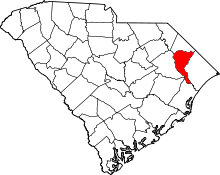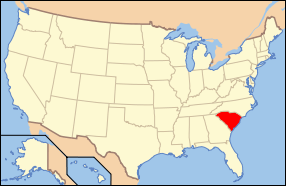Marion County, South Carolina
| Marion County, South Carolina | |
|---|---|
 Location in the U.S. state of South Carolina | |
 South Carolina's location in the U.S. | |
| Founded | 1800 |
| Seat | Marion |
| Largest city | Marion |
| Area | |
| • Total | 494 sq mi (1,279 km2) |
| • Land | 489 sq mi (1,267 km2) |
| • Water | 4.9 sq mi (13 km2), 1.0% |
| Population | |
| • (2010) | 33,062 |
| • Density | 68/sq mi (26/km²) |
| Congressional district | 7th |
| Time zone | Eastern: UTC-5/-4 |
| Website |
www |
Marion County is a county located in the U.S. state of South Carolina. As of the 2010 census, its population was 33,062.[1] Its county seat is Marion.[2] The county was created in 1785 and was originally known as Liberty County. However, four years later it was renamed Marion County, in honor Brigadier General Francis Marion,[3] the famous "Swamp Fox" and a hero of the American Revolutionary War.
Geography
According to the U.S. Census Bureau, the county has a total area of 494 square miles (1,280 km2), of which 489 square miles (1,270 km2) is land and 4.9 square miles (13 km2) (1.0%) is water.[4]
Adjacent counties
- Dillon County - north
- Horry County - east
- Georgetown County - south
- Williamsburg County - southwest
- Florence County - west
National protected area
Major highways
Demographics
| Historical population | |||
|---|---|---|---|
| Census | Pop. | %± | |
| 1800 | 6,914 | — | |
| 1810 | 8,884 | 28.5% | |
| 1820 | 10,201 | 14.8% | |
| 1830 | 11,208 | 9.9% | |
| 1840 | 13,932 | 24.3% | |
| 1850 | 17,407 | 24.9% | |
| 1860 | 21,190 | 21.7% | |
| 1870 | 22,160 | 4.6% | |
| 1880 | 34,107 | 53.9% | |
| 1890 | 29,976 | −12.1% | |
| 1900 | 35,181 | 17.4% | |
| 1910 | 20,596 | −41.5% | |
| 1920 | 23,721 | 15.2% | |
| 1930 | 27,221 | 14.8% | |
| 1940 | 30,107 | 10.6% | |
| 1950 | 33,110 | 10.0% | |
| 1960 | 32,014 | −3.3% | |
| 1970 | 30,270 | −5.4% | |
| 1980 | 34,179 | 12.9% | |
| 1990 | 33,899 | −0.8% | |
| 2000 | 35,466 | 4.6% | |
| 2010 | 33,062 | −6.8% | |
| Est. 2015 | 31,747 | [5] | −4.0% |
| U.S. Decennial Census[6] 1790-1960[7] 1900-1990[8] 1990-2000[9] 2010-2013[1] | |||
2000 census
As of the census[10] of 2000, there were 35,466 people, 13,301 households, and 9,510 families residing in the county. The population density was 72 people per square mile (28/km²). There were 15,143 housing units at an average density of 31 per square mile (12/km²). The racial makeup of the county was 41.69% White, 56.35% Black or African American, 0.25% Native American, 0.28% Asian, 0.01% Pacific Islander, 0.90% from other races, and 0.52% from two or more races. 1.79% of the population were Hispanic or Latino of any race.
There were 13,301 households out of which 32.20% had children under the age of 18 living with them, 43.30% were married couples living together, 23.60% had a female householder with no husband present, and 28.50% were non-families. 25.40% of all households were made up of individuals and 9.70% had someone living alone who was 65 years of age or older. The average household size was 2.64 and the average family size was 3.16.
In the county, the population was spread out with 27.60% under the age of 18, 9.70% from 18 to 24, 26.80% from 25 to 44, 23.80% from 45 to 64, and 12.10% who were 65 years of age or older. The median age was 35 years. For every 100 females there were 85.90 males. For every 100 females age 18 and over, there were 80.40 males.
The median income for a household in the county was $26,526, and the median income for a family was $32,932. Males had a median income of $26,133 versus $18,392 for females. The per capita income for the county was $13,878. About 18.90% of families and 23.20% of the population were below the poverty line, including 33.30% of those under age 18 and 23.50% of those age 65 or over.
According to the 2010 U.S. Religious Census, Marion County had the highest concentration of followers of the Bahá'í Faith of any county in the United States, at 5.5%.[11]
2010 census
As of the 2010 United States Census, there were 33,062 people, 13,058 households, and 8,881 families residing in the county.[12] The population density was 67.6 inhabitants per square mile (26.1/km2). There were 14,953 housing units at an average density of 30.6 per square mile (11.8/km2).[13] The racial makeup of the county was 55.9% black or African American, 40.6% white, 0.5% Asian, 0.4% American Indian, 1.3% from other races, and 1.2% from two or more races. Those of Hispanic or Latino origin made up 2.4% of the population.[12] In terms of ancestry, 7.8% were American, 6.3% were English, and 5.2% were Irish.[14]
Of the 13,058 households, 33.4% had children under the age of 18 living with them, 38.0% were married couples living together, 24.9% had a female householder with no husband present, 32.0% were non-families, and 28.5% of all households were made up of individuals. The average household size was 2.52 and the average family size was 3.09. The median age was 39.9 years.[12]
The median income for a household in the county was $30,629 and the median income for a family was $38,043. Males had a median income of $32,414 versus $24,929 for females. The per capita income for the county was $16,653. About 21.4% of families and 25.1% of the population were below the poverty line, including 36.8% of those under age 18 and 19.1% of those age 65 or over.[15]
Communities
Cities
Towns
Unincorporated communities
- Ariel Crossroad
- Brittons Neck
- Centenary
- Friendship
- Gresham
- Rains
- Temperance Hill
Historic places
|
|
References
- 1 2 "State & County QuickFacts". United States Census Bureau. Retrieved November 25, 2013.
- ↑ "Find a County". National Association of Counties. Retrieved 2011-06-07.
- ↑ Gannett, Henry (1905). The Origin of Certain Place Names in the United States. U.S. Government Printing Office. p. 200.
- ↑ "2010 Census Gazetteer Files". United States Census Bureau. August 22, 2012. Retrieved March 18, 2015.
- ↑ "County Totals Dataset: Population, Population Change and Estimated Components of Population Change: April 1, 2010 to July 1, 2015". Retrieved July 2, 2016.
- ↑ "U.S. Decennial Census". United States Census Bureau. Retrieved March 18, 2015.
- ↑ "Historical Census Browser". University of Virginia Library. Retrieved March 18, 2015.
- ↑ Forstall, Richard L., ed. (March 27, 1995). "Population of Counties by Decennial Census: 1900 to 1990". United States Census Bureau. Retrieved March 18, 2015.
- ↑ "Census 2000 PHC-T-4. Ranking Tables for Counties: 1990 and 2000" (PDF). United States Census Bureau. April 2, 2001. Retrieved March 18, 2015.
- ↑ "American FactFinder". United States Census Bureau. Retrieved 2011-05-14.
- ↑ Religious Congregations and Membership Study. "2010 Religious Census Data" (PDF). Association of Statisticians of American Religious Bodies. Retrieved 7 May 2012.
- 1 2 3 "DP-1 Profile of General Population and Housing Characteristics: 2010 Demographic Profile Data". United States Census Bureau. Retrieved 2016-03-11.
- ↑ "Population, Housing Units, Area, and Density: 2010 - County". United States Census Bureau. Retrieved 2016-03-11.
- ↑ "DP02 SELECTED SOCIAL CHARACTERISTICS IN THE UNITED STATES – 2006-2010 American Community Survey 5-Year Estimates". United States Census Bureau. Retrieved 2016-03-11.
- ↑ "DP03 SELECTED ECONOMIC CHARACTERISTICS – 2006-2010 American Community Survey 5-Year Estimates". United States Census Bureau. Retrieved 2016-03-11.
External links
- Sellers, W. W. (William W.). A history of Marion county, South Carolina, from its earliest times to the present, 1901 (1902) on the Internet Archive
- 1905 Reprint of Bishop Gregg's History of the Old Cheraws with additional material as an appendix. (Google Book pdf)
 |
Dillon County |  | ||
| Florence County | |
Horry County | ||
| ||||
| | ||||
| Williamsburg County | Georgetown County |
Coordinates: 34°05′N 79°22′W / 34.08°N 79.36°W